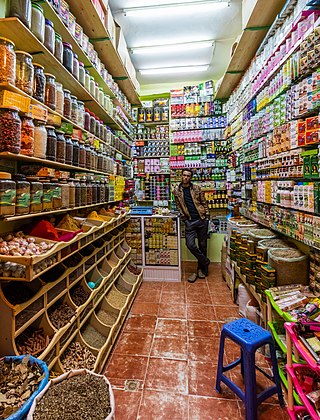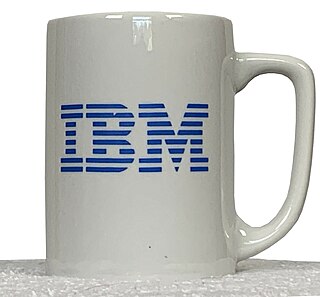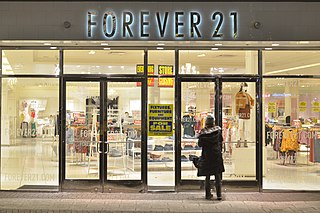
A convenience store, bodega, convenience shop, corner store or corner shop is a small retail store that stocks a range of everyday items such as tea, coffee, groceries, fruits, vegetables, snacks, confectionery, soft drinks, ice creams, tobacco products, lottery tickets, over-the-counter drugs, toiletries, newspapers and magazines. In some jurisdictions, convenience stores are licensed to sell alcoholic drinks, although many jurisdictions limit such beverages to those with relatively low alcohol content, like beer and wine. The stores may also offer money order and wire transfer services, along with the use of a fax machine or photocopier for a small per-copy cost. Some also sell tickets or recharge smart cards, e.g. OPUS cards in Montreal or include a small deli. They differ from general stores and village shops in that they are not in a rural location and are used as a convenient supplement to larger stores.

A supermarket is a self-service shop offering a wide variety of food, beverages and household products, organized into sections. This kind of store is larger and has a wider selection than earlier grocery stores, but is smaller and more limited in the range of merchandise than a hypermarket or big-box market. In everyday U.S. usage, however, "grocery store" is often used to mean "supermarket".

Retail is the sale of goods and services to consumers, in contrast to wholesaling, which is sale to business or institutional customers. A retailer purchases goods in large quantities from manufacturers, directly or through a wholesaler, and then sells in smaller quantities to consumers for a profit. Retailers are the final link in the supply chain from producers to consumers.

The point of sale (POS) or point of purchase (POP) is the time and place at which a retail transaction is completed. At the point of sale, the merchant calculates the amount owed by the customer, indicates that amount, may prepare an invoice for the customer, and indicates the options for the customer to make payment. It is also the point at which a customer makes a payment to the merchant in exchange for goods or after provision of a service. After receiving payment, the merchant may issue a receipt for the transaction, which is usually printed but can also be dispensed with or sent electronically.

Shoplifting, shop theft, retail theft, or retail fraud is the theft of goods from a retail establishment during business hours, typically by concealing a store item on one's person, in pockets, under clothes or in a bag, and leaving the store without paying. With clothing, shoplifters may put on items from the store and leave the store wearing the clothes. The terms shoplifting and shoplifter are not usually defined in law. The crime of shoplifting generally falls under the legal classification of larceny. Shoplifting is distinct from burglary, robbery, or armed robbery. In the retail industry, the word shrinkage can be used to refer to merchandise lost by shoplifting, but the word also includes loss by other means, such as waste, uninsured damage to products and theft by store employees.
Pak'nSave is a New Zealand discount food supermarket warehouse chain owned by the Foodstuffs cooperative. It is one of the three main supermarket chains in New Zealand, alongside Countdown and New World. There is a total of 57 Pak'nSave stores throughout the country.

Merchandising is any practice which contributes to the sale of products to a retail consumer. At a retail in-store level, merchandising refers to displaying products that are for sale in a creative way that entices customers to purchase more items or products.

Online shopping is a form of electronic commerce which allows consumers to directly buy goods or services from a seller over the Internet using a web browser or a mobile app. Consumers find a product of interest by visiting the website of the retailer directly or by searching among alternative vendors using a shopping search engine, which displays the same product's availability and pricing at different e-retailers. As of 2020, customers can shop online using a range of different computers and devices, including desktop computers, laptops, tablet computers and smartphones.
Bagger, packer, sacker or bag boy (US) is an unofficial title given to a courtesy clerk at a grocery store.
Service Merchandise was a retail chain of catalog showrooms carrying jewelry, toys, sporting goods and electronics. The company, which first began in 1934 as a five-and-dime store, was in existence for 68 years before ceasing operations in 2002.

Self-checkouts (SCOs), also known as assisted checkouts (ACOs) or self-service checkouts, are machines that provide a mechanism for customers to complete their own transaction from a retailer without needing a traditional staffed checkout. When using SCOs, customers scan item barcodes before paying for their total shop without needing one-to-one staff assistance. Self-checkouts are used mainly in supermarkets, although they are not uncommon in department or convenience stores. Most self-checkout areas are supervised by at least one staff member, often assisting customers process transactions, correcting prices, or otherwise providing service.

A closeout or clearance sale is a discount sale of inventory either by retail or wholesale. It may be that a product is not selling well, or that the retailer is closing because of relocation, a fire, over-ordering, or especially because of bankruptcy. In the latter case, it is usually known as a going-out-of-business sale or liquidation sale, and is part of the process of liquidation. A hail sale is a closeout at a car dealership after hail damage.
A catalog merchant is a form of retailing. The typical merchant sells a wide variety of household and personal products, with many emphasizing jewelry. Unlike a self-serve retail store, most of the items are not displayed; customers select the products from printed catalogs in the store and fill out an order form. The order is brought to the sales counter, where a clerk retrieves the items from the warehouse area to a payment and checkout station.
Marion Barton Skaggs was an American businessman and leading member of the Skaggs Family of retailers who expanded the predecessor of Safeway into a major supermarket chain.
Customer service representatives, customer service advisors, customer service agents, or customer service associates are employees who interact with customers to handle and resolve complaints, process orders, and provide information about an organization’s products and services. They may work in an office with a call center or in retail. Customer service representatives answer questions or requests from customers or the public. They typically provide services by phone, but some also interact with customers face to face, by email or text, via live chat, and through social media. Qualifications include good communication, problem-solving, and computer skills.

Once the strategic plan is in place, retail managers turn to the more managerial aspects of planning. A retail mix is devised for the purpose of coordinating day-to-day tactical decisions. The retail marketing mix typically consists of six broad decision layers including product decisions, place decisions, promotion, price, personnel and presentation. The retail mix is loosely based on the marketing mix, but has been expanded and modified in line with the unique needs of the retail context. A number of scholars have argued for an expanded marketing, mix with the inclusion of two new Ps, namely, Personnel and Presentation since these contribute to the customer's unique retail experience and are the principal basis for retail differentiation. Yet other scholars argue that the Retail Format should be included. The modified retail marketing mix that is most commonly cited in textbooks is often called the 6 Ps of retailing.

Visual merchandising is the practice in the retail industry of optimizing the presentation of products and services to better highlight their features and benefits. The purpose of such visual merchandising is to attract, engage, and motivate the customer towards making a purchase.

Pyaterochka is a Russian chain of convenience stores managed by X5 Retail Group. The chain opened its 15,000th store in the city of Zelenograd, Russia, in May 2019.
The retail format influences the consumer's store choice and addresses the consumer's expectations. At its most basic level, a retail format is a simple marketplace, that is; a location where goods and services are exchanged. In some parts of the world, the retail sector is still dominated by small family-run stores, but large retail chains are increasingly dominating the sector, because they can exert considerable buying power and pass on the savings in the form of lower prices. Many of these large retail chains also produce their own private labels which compete alongside manufacturer brands. Considerable consolidation of retail stores has changed the retail landscape, transferring power away from wholesalers and into the hands of the large retail chains.

A cashierless store is a store which allows customers to shop their products and leave without having to wait in line and pay at a checkout. There are four phases when purchasing from a cashierless store: the before-purchase phase, the check-in phase, the product selection phase, and the check-out phase. Each cashierless store utilizes different combinations of technology within these phases. However, generally cashierless stores use sensor fusion and deep learning for computer vision to keep track of customers and products. Existing cashierless stores can currently be found in the United States, Asia, Europe, the Middle East, and Africa.












